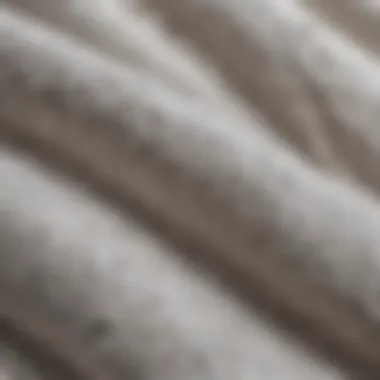Exploring Non-Woven Cotton Fabric: Uses and Impact


Intro
Non-woven cotton fabric represents a significant advancement in textile technology. Its unique characteristics stem from a different manufacturing process compared to traditional woven fabrics. Crafted by entangling fibers through mechanical, thermal, or chemical means, this fabric showcases distinct advantages and a wide range of applications. Understanding these properties is essential as they influence the material's utility across various industries.
The growing demand for sustainable materials in the textile sector has placed non-woven cotton fabric in the spotlight. As industries strive to address environmental concerns, this material's environmental impact becomes a subject of critical importance. This article will explore the properties, applications, and sustainability aspects of non-woven cotton fabric, serving as a comprehensive guide for students, researchers, and professionals in related fields.
Prelude to Non-Woven Cotton Fabric
The exploration of non-woven cotton fabric is fundamental to understanding its varied uses and implications in today's world. This fabric type stands apart from traditional woven textiles through its unique characteristics and the methodology of production. Non-woven cotton fabric is not only significant in the textile industry, but it also plays a vital role in medical, industrial, and environmental contexts.
The increased interest in non-woven materials can be attributed to several key factors. Firstly, these fabrics demonstrate superior versatility. From hygiene products to fashion accessories, non-woven cotton can be adapted easily to various applications. Secondly, their manufacturing process offers potential benefits such as cost-effectiveness and lesser environmental impact when compared to conventional fabric types.
This article delves deeper into these aspects, highlighting how understanding these fabrics can inform better choices regarding material selection. Mitigating the environmental challenges associated with textile production is critical. Hence, we will explore the sustainability of non-woven cotton and its lifecycle implications. The aim is to provide students, researchers, educators, and professionals with a comprehensive look into non-woven cotton, paving the way for further discussions about its potentials and limitations.
Definition and Overview
Non-woven cotton fabric is material created by bonding fibers together through various methods like heat, chemicals, or mechanical processes. Unlike traditional woven fabrics, which require interlacing yarns, non-woven textiles are constructed without the need for any knitting or weaving. This distinct formation leads to various styles and functional attributes, differentiating it from conventional cotton fabrics.
Non-woven cotton can be engineered to exhibit properties such as softness, strength, and filtration capabilities. Additionally, it often features a unique texture that enhances its usability in many scenarios, ranging from health care to domestic products.
Historical Context
The history of non-woven fabric dates back to the mid-20th century with the introduction of synthetic materials. Initially, non-woven fabrics focused on industrial applications and hygiene products. By the 1970s, manufacturers recognized non-woven cotton's potential to address consumer needs beyond industrial utilities. Its adaptability meant that it could be utilized in clothing, home furnishing, and medical supplies, among others.
Over time, innovations in manufacturing processes have expanded the applications of non-woven cotton. As environmental concerns grew, options for using natural fibers, like cotton, became prominent. Its sustainable nature and organic profile positioned non-woven cotton as a viable alternative among various material types. The continuous advancements in technologies and processes contribute to its growing acceptance and use across multiple sectors.
Composition of Non-Woven Cotton Fabric
The composition of non-woven cotton fabric is fundamental to understanding its unique properties and applications. Unlike traditional woven fabrics, non-woven materials are produced through a variety of processes that bond fibers together without weaving. This method results in a fabric that boasts distinct characteristics, which lends itself to various uses in different sectors.
Material Properties
Non-woven cotton fabric stands out due to specific material properties that enhance its performance. These properties stem from the type of fibers used, their arrangement, and the bonding techniques applied during production. Commonly, cotton fibers are chosen for their natural softness, breathability, and moisture-absorbing abilities. This makes non-woven cotton ideal for applications requiring comfort and functionality. Some of the key properties include:
- Texture: Non-woven cotton typically has a soft finish, making it pleasant to touch. The absence of weaving allows for smooth surfaces that are appealing in both textile and fashion industries.
- Durability: Enhanced durability comes from the bonding methods employed. The combination of fibers results in a fabric that resists tearing and maintains integrity over time, which is especially important in industrial uses.
- Weight: Depending on the manufacturing process, non-woven cotton can be produced in various weights. Lightweight options are suitable for medical applications like surgical masks, whereas heavier variants might be utilized in industrial products.
Manufacturing Processes
Manufacturing non-woven cotton fabric involves several processes that contribute to the final product's characteristics. Each technique plays a role in determining the fabric's suitability for different applications.
Chemicals Used
The use of chemicals in the production of non-woven cotton fabric is a critical factor that allows manufacturers to enhance specific properties. Chemicals are commonly incorporated during the bonding process to improve the fabric's strength and reduce moisture absorption. One key characteristic is the use of adhesives, which bond fibers without the need for traditional weaving. This aspect makes bonding efficient and cost-effective. However, the use of certain chemicals can raise concerns regarding environmental impact and toxicity. Thus, manufacturers increasingly seek to utilize eco-friendly options that fulfill performance needs without compromising safety.
Production Techniques
Various production techniques are employed to create non-woven cotton fabric, each offering its advantages. Common methods include spunbonding, meltblowing, and needle punching. These techniques determine the subsequent properties of the fabric.


One significant characteristic of spunbonding is its ability to produce continuous filaments, resulting in fabrics that are lightweight yet resilient. This technique is favored in medical applications due to its strength and filtration capabilities.
Another feature of meltblowing involves creating extremely fine fibers, which significantly enhance water resistance. However, while these methods create desirable features, they also come with disadvantages such as increased production costs and the need for specialized equipment. These elements contribute to both the overall quality and the economic viability of non-woven cotton fabric in various industries.
"Understanding the composition of non-woven cotton fabric is essential in optimizing its applications, especially in fields where efficiency and performance are crucial."
"Understanding the composition of non-woven cotton fabric is essential in optimizing its applications, especially in fields where efficiency and performance are crucial."
The synergy between material properties and the manufacturing processes of non-woven cotton fabric creates a versatile and functional textile. As industries continue to explore innovative applications, the comprehensive knowledge of its composition will guide the development of sustainable and effective products.
Characteristics of Non-Woven Cotton Fabric
The characteristics of non-woven cotton fabric are critical for understanding its performance and applications. Various physical and functional attributes define what makes this material suitable for different uses. These characteristics not only impact end-user experiences but also influence production techniques and sustainability efforts. A careful examination of texture, durability, weight, water resistance, and air permeability reveals how these factors contribute to the material's appeal.
Physical Attributes
Texture
The texture of non-woven cotton fabric plays a fundamental role in its application. It often offers a soft, smooth surface which makes it pleasant to touch. This quality is especially noteworthy for products that come in direct contact with skin, such as medical dressings or clothing. A soft texture enhances comfort, making it an advantageous choice for consumer-facing products.
However, texture can vary based on manufacturing practices. Some processes yield a coarser material, which may be less desirable for applications requiring gentleness. Therefore, selecting the right texture is essential in aligning the fabric's attributes with its intended usage.
Durability
Durability is a significant characteristic that distinguishes non-woven cotton fabric from other materials. This type of fabric can withstand considerable stress and wear, making it suitable for applications in healthcare and construction. The resilience of non-woven cotton contributes to its long life span, reducing the need for frequent replacements.
One unique feature of its durability is its resistance to tearing and puncturing. This attribute is particularly beneficial in medical gowns or industrial wipes, where material integrity is crucial. Nonetheless, while non-woven cotton is durable, its lifespan can be shortened by improper care or exposure to harsh environments.
Weight
Weight is another essential factor that influences the usability of non-woven cotton fabric. Typically, it is lightweight, which enhances its versatility. A lighter fabric is often easier to manage and use in various applications, from fashion accessories to industrial products.
Moreover, the low weight can lead to cost savings in shipping and storage. However, it is important to note that a very lightweight fabric may sacrifice some durability and structural integrity. Striking a balance between weight and strength is vital when choosing non-woven cotton for specific applications.
Functional Attributes
Water Resistance
Water resistance is a pivotal functional attribute of non-woven cotton fabric, making it particularly useful in several industries. Many applications, especially in healthcare and outdoor gear, benefit from the fabric's ability to repel water. This characteristic can help prevent moisture-related issues, such as the growth of bacteria or mold.
The key characteristic here is the fabric's ability to retain its mechanical properties even when exposed to moisture. Yet, not all non-woven cotton fabrics are the same in this regard. Some may require additional treatments to enhance water resistance. Understanding these differences is crucial for applications where water exposure is frequent.
Air Permeability
Air permeability refers to the ease with which air can pass through the fabric. This characteristic is vital for applications that require breathability, such as medical dressings and clothing. An air-permeable fabric allows for better ventilation, reducing discomfort for users who might otherwise feel hot or trapped.
The major advantage of air permeability is that it supports moisture management, allowing sweat to evaporate and keeping the skin dry. However, high permeability can also present challenges in terms of filtration, as contaminants have easier access to the fabric's internal structure. Therefore, proper evaluation of air permeability is essential based on the intended end use.
Applications of Non-Woven Cotton Fabric


The versatile applications of non-woven cotton fabric play a crucial role in various sectors. This fabric's unique properties allow it to be utilized in many ways, providing significant benefits across medical, fashion, and industrial fields. Understanding these applications can highlight the fabric's importance in meeting modern demands efficiently and sustainably.
Medical and Healthcare
Surgical Masks
Surgical masks made from non-woven cotton fabric are one of the most significant applications in the medical field. These masks play a vital role in infection control. The key characteristic of surgical masks is their effective barrier against pathogens. Non-woven cotton is favored due to its ability to filter small particles while maintaining breathability.
The unique feature of surgical masks is their layered structure. This structure improves filtration efficiency, ensuring that both healthcare professionals and patients are protected. However, a disadvantage can be their disposability, leading to increased waste in medical settings. Despite this, they remain a popular choice due to their practicality and effectiveness in reducing airborne transmission of diseases.
Comfortable Dressings
Comfortable dressings made from non-woven cotton fabric also show a notable impact in healthcare. These dressings contribute to patient comfort and wound care by being soft against the skin. The key characteristic of these dressings is their absorbency, which helps manage exudate effectively.
A unique advantage of comfortable dressings is their ability to conform to body contours. This property allows for a snug fit, enhancing healing processes. On the downside, they may not be suitable for all types of wounds, especially where high absorption is necessary. Nonetheless, they are recognized for preventing skin irritation and promoting patient satisfaction.
Textiles and Fashion
Fashion Accessories
Fashion accessories produced using non-woven cotton fabric have garnered attention in recent years. Their application in this area highlights the creative possibilities of the material. The key characteristic here is the fabric's ability to be textured and printed easily, allowing for diverse designs and styles.
A unique feature of non-woven cotton fashion accessories is their lightweight nature. This makes them convenient for everyday use, appealing to eco-conscious consumers. However, their durability may not match traditional woven fabrics, potentially limiting their usage in some high-wear scenarios. Despite this, their appeal continues to grow due to unique aesthetics and sustainable sourcing.
Cotton Home Goods
Non-woven cotton is also used in home goods, offering various functional applications. The key characteristic of these products—including tote bags and decorative items—is their practicality combined with style. Non-woven cotton home goods encourage sustainability through the use of natural fibers.
An advantage of cotton home goods is their ease of maintenance. They are often washable, adding to their longevity. However, the environmental impact can still be a concern if the production processes are not managed responsibly. Overall, the trend towards using non-woven cotton in home goods is driven by increasing consumer demand for eco-friendly products.
Industrial Uses
Filtration Media
In industrial applications, non-woven cotton fabric is widely used as filtration media. This use emphasizes the material's functional properties, particularly its filtration efficiency. The key characteristic of this application is the fabric's ability to capture a wide range of particles, making it valuable in various industrial processes.
The unique feature of non-woven cotton as filtration media is its customizable thickness and density, allowing for tailored solutions for specific filtration needs. However, some drawbacks involve the potential cost of certain formulations, which may limit accessibility for smaller operations. Yet, the effectiveness of non-woven cotton in these roles is well-recognized in the industry.
Geotextiles
Geotextiles made from non-woven cotton play a significant role in civil engineering and construction. This material acts as a barrier and stabilizer in various projects. The key characteristic is its ability to support soil structures while allowing for water flow, which reduces erosion.
A unique advantage of non-woven cotton geotextiles is their environmental compatibility. Made from natural fibers, they can integrate with soil, promoting sustainability in construction practices. On the downside, their performance may be affected by specific environmental conditions, such as humidity. Nevertheless, their growing application in infrastructure projects underscores their importance as a resource-efficient material.
Environmental Impacts of Non-Woven Cotton Fabric
Understanding the environmental impacts of non-woven cotton fabric is crucial in today's context. As industries look for sustainable materials, non-woven fabrics can both offer benefits and present challenges. Evaluating these elements helps industries make informed choices that adhere to sustainability goals.


Sustainability Considerations
Sustainability is a key factor in assessing non-woven cotton fabrics. The material is derived from natural cotton fibers, which align with an eco-friendly approach when compared to synthetic alternatives. Cotton itself is biodegradable. However, depending on the processing methods and treatments, this can vary. Considerations must include:
- Resource Intensity: Cotton farming requires significant water and land resources. The impact of intensive agriculture cannot be overlooked.
- Chemical Treatments: Many non-woven fabrics undergo treatment with chemicals, which may have adverse environmental effects. Understanding the specific chemicals used can provide clarity on environmental risks.
- End-of-Life: Whether the fabric is compostable or recyclable affects its sustainability posture.
In summary, while non-woven cotton fabrics may offer several advantages over synthetic options, their sustainability is context-dependent.
Lifecycle Analysis
A lifecycle analysis offers insight into the environmental impact from cradle to grave. This includes all stages: production, utilization, and disposal. Within this analysis, specific emphasis is given to two areas: production footprint and disposal methods.
Production Footprint
The production footprint of non-woven cotton fabric is significant. This term encompasses all resources used during the manufacturing stage. Key characteristics of this footprint include:
- Energy Consumption: Non-woven fabric production typically involves high energy requirements, which can contribute to a larger carbon footprint. Reducing energy use is vital for enhancing sustainability.
- Raw Material Sourcing: The origin of cotton fibers is important. Locally sourced materials may have a smaller environmental impact compared to those transported long distances.
- Waste Generation: The production process can result in waste. Adopting strategies to minimize waste can enhance sustainability efforts.
Due to these factors, understanding and optimizing the production footprint is essential for reducing overall environmental impact.
Disposal Methods
Disposal methods for non-woven cotton fabric also play a significant role in its environmental impact. Various disposal routes include:
- Landfill: If non-woven cotton is discarded in landfills, it contributes to waste accumulation. This can degrade local environments and ecosystems over time.
- Composting: Biodegradable non-woven fabrics can decompose when composted correctly. This method is environmentally beneficial, as it returns nutrients to the soil.
- Recycling Programs: Implementing recycling programs can help recapture materials and reduce waste.
Understanding these disposal methods is essential for mitigating negative environmental impacts. Each disposal choice has its advantages and disadvantages, which must be carefully weighed against environmental goals and practices.
"The environmental impact of non-woven cotton fabric is intertwined with both its production and disposal processes, affecting sustainability at every stage of its lifecycle."
"The environmental impact of non-woven cotton fabric is intertwined with both its production and disposal processes, affecting sustainability at every stage of its lifecycle."
Future Prospects for Non-Woven Cotton Fabric
The future of non-woven cotton fabric is shaped by multiple influences, including technological advances, shifting consumer preferences, and increasing environmental awareness. Within this context, it is essential to explore key developments that may redefine the landscape of non-woven fabrics.
Technological Innovations
The realm of non-woven cotton fabric is witnessing rapid technological innovations. One of the notable advancements is the evolution of production techniques. New methods, such as the use of hydroentanglement and spunlace processes, have enhanced the quality and properties of the fabric.
Improved machinery also plays a critical role. Automated and high-speed production lines increase efficiency while maintaining consistency in fabric quality. This evolution results in more durable and versatile products.
Another significant innovation lies in the use of biodegradable polymers. Integrating these materials with non-woven processes leads to eco-friendly alternatives, thus addressing sustainability concerns directly. Ultrasonic welding technology further ensures that production is energy-efficient, reducing the overall environmental footprint.
"The integration of superior production techniques may revolutionize our approach to textile manufacturing, making it both efficient and sustainable."
"The integration of superior production techniques may revolutionize our approach to textile manufacturing, making it both efficient and sustainable."
Market Trends
As the market for non-woven cotton fabric expands, several trends are emerging. There is a growing demand in sectors such as medical, automotive, and fashion. The healthcare industry, in particular, has seen increased needs for items like surgical masks and gowns, especially during health crises such as the COVID-19 pandemic.
Additionally, consumers are gravitating toward sustainable options. Brands are increasingly highlighting the recyclable nature of non-woven cotton fabric while emphasizing responsible sourcing. This trend aligns with global movements advocating for eco-friendly practices, influencing companies to innovate toward greener solutions.
Furthermore, the rise of e-commerce is affecting how non-woven cotton products are marketed and sold. Online platforms allow for direct-to-consumer sales, changing traditional retail dynamics. This shift might also expand the reach of manufacturers to new markets, both domestically and globally.



